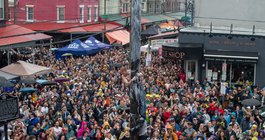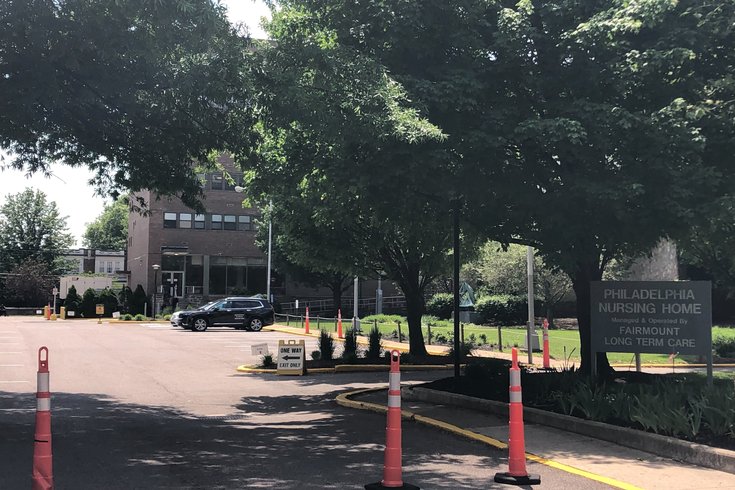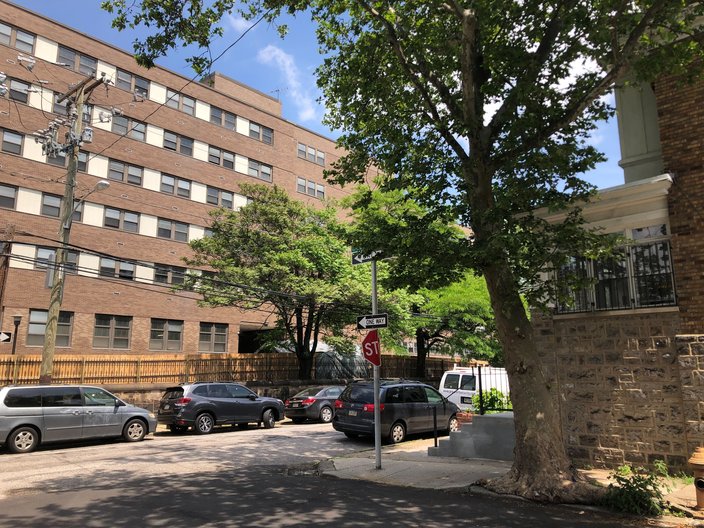
May 20, 2024
 John Kopp/PhillyVoice
John Kopp/PhillyVoice
The Parker administration intends to use the homeless shelter at 2100 W. Girard Ave. in Fairmount to also help people with addiction. The plan has created an outcry among some neighbors who say the city has not sought community input. The facility was a nursing home as recently as 2022.
Earlier this spring, the city quietly began working to add beds and services at a Fairmount homeless shelter. But when word spread of the plans, residents got a little loud.
The center in contention is the state-owned facility at 2100 W. Girard Ave., which has provided shelter for homeless people since the Philadelphia Nursing Home exited the site in 2022. City officials reportedly plan to convert the walled-off space into one of Mayor Cherelle Parker's proposed triage and wellness centers to help people with addiction. Fairmount neighbors have started a petition — which had 1,175 signatures as of Monday morning — to halt the development of what the city is calling Philly Home at Girard. Some later shouted down city officials at a meeting to discuss the plans.
But a University of Pennsylvania expert said he hopes the parties can come to an agreement, arguing that centers like these are desperately needed to address Philadelphia's addiction crisis.
"I'm sympathetic to the notion that we need to engage (the community)," said Dominic Sisti, an associate professor of medical ethics and health policy at Penn. "But I would weigh that against the ethical obligation to take care of people who are literally dying on the streets."
Sisti said a NIMBY mentality — short for "not in my backyard" — often crops up around new inpatient or crisis centers for people with addiction and mental illness. This is seemingly rooted in a perception that they are more dangerous or prone to crime, a stigma that can impede access to care.
"An individual with a serious mental illness, who's in crisis, who's in psychosis, is really different, right?" Sisti said. "They act in a way that's very different than what we expect, and that can be jarring and scary. It's a protection impulse, I get that. But really the evidence that an individual with a mental illness is gonna be really dangerous is not very strong.
"You hear people say, 'well, mentally ill people are typically the victims of violence, not perpetrators.' And I think that's generally true."
Statistics support this. A 2003 analysis of the relationship between violence and mental illness linked as little as 3% of violent crimes to people with major mental disorders such as clinical depression or schizophrenia, and an additional 7% to perpetrators with substance use disorder. Conversely, an earlier study found that 62.8% of psychiatric inpatients reported physical victimization from an intimate partner, while nearly half experienced violence from a family member.
"Members of the public undoubtedly exaggerate both the strength of the relationship between major mental disorders and violence, as well as their own personal risk from the severely mentally ill," the 2003 analysis concluded.
Sisti likened the rate of addiction in Philadelphia to a "public health catastrophe" deserving an emergency response. Housing is the first step — and a necessary one to access medical benefits or communicate with a doctor — but he said inpatient units, drug rehabilitation centers and harm reduction spaces are also on the "menu of options we need."
There has been considerable confusion over what services would be offered at the Parker administration's triage and wellness centers. City officials have characterized the Fairmount facility as a wellness center. City spokesperson Joe Grace has not elaborated on the differences between triage and wellness centers, but he said "the team plans to be responsive to the extant needs of those seeking assistance with stabilization, recovery, and wellness as the key objectives" as Philly Home at Girard continues to increase capacity.
 John Kopp/for PhillyVoice
John Kopp/for PhillyVoiceBradley Mayer, who started the petition, lives one block east of the facility.
The man who started the petition against the shelter's immediate development said confusion was at the heart of his action, and bemoaned "contradictory" information from the city on the project's aims.
"My main goal with the petition wasn't the traditional NIMBY-type mentality, 'Hey, we've got to stop this,'" said Bradley Mayer, the petition creator. "It was really more, 'Hey, this is happening. We need to get more information about it.' The city, the mayor and the agencies involved need to be a bit more open and tell the neighborhood what's going on, tell them what it's being used for, what their plans are to deal with the potential outcomes."
The Fairmount facility opened as a hospital in the late 19th century, and became a nursing home in late 1970s. Beginning in 2014, the city also began using it as additional shelter space, particularly during the winter months, city spokesperson Sharon Gallagher said.
Since 2023, it has served as the temporary replacement site for more than 60 homeless adults who had been living in the Fernwood Cottage at Riverview Home, Gallagher said. Over the winter, the Office of Homeless Services began using it for "winter initiative programming." It housed nearly 100 people every night through April, but two floors remained vacant.
Renovations to expand the facility began in April, with the goal of adding 75 beds; the first five residents of the facility's expanded programming were accepted May 1, according to the city. As of Monday, the facility had 48 residents.
Sisti said he hopes the city and Fairmount residents can reach an understanding that results in more beds and services, as well as more empathy for people living on the streets.
"It's just not really excusable to say, 'Oh, they're different, so we should cordon them off and isolate 'em and send 'em away,'" he said. "The fact is people can recover and do really well with the right treatment. And so that's the aim, and ... I do think there should be ways to ensure the safety and integrity of the neighborhood, too. I think it's important that we do both."
Follow Kristin & PhillyVoice on Twitter: @kristin_hunt
| @thePhillyVoice
Like us on Facebook: PhillyVoice
Have a news tip? Let us know.